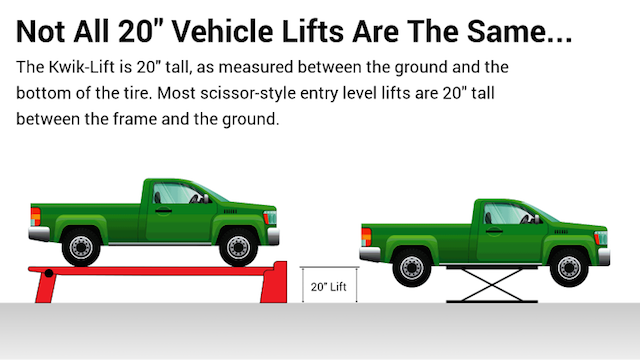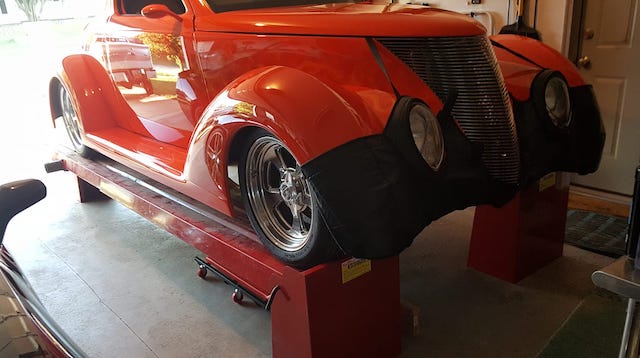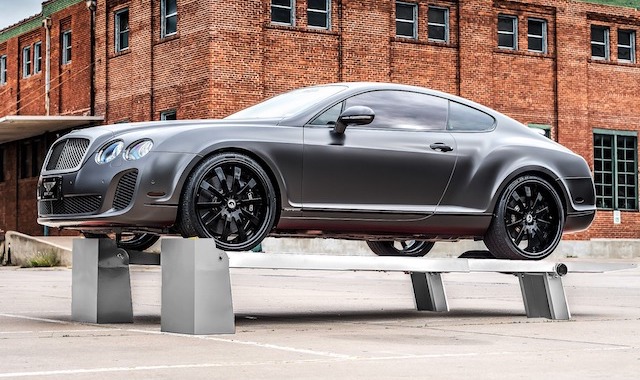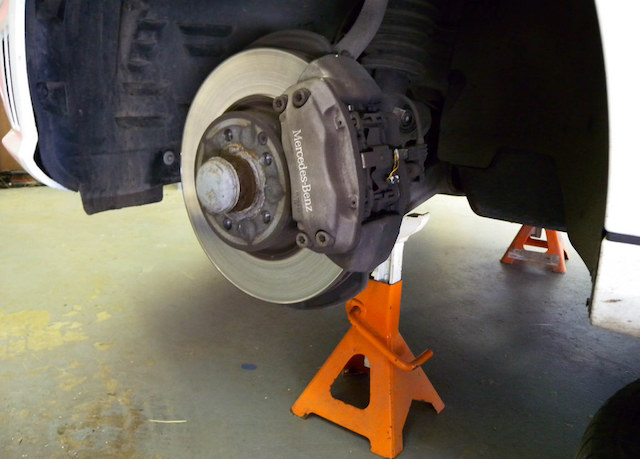
If you’re the kind of person that likes to work on your car for fun, odds are pretty good that you can put a vehicle lift to good use. While a lift isn’t a small investment, it has a lot of benefits for DIYers:
- A home garage lift will save time on many repairs
- A home garage lift will reduce the stress and strain on your body that comes from working bent over (or in cramped spaces)
- A home garage lift makes it possible to complete jobs that would difficult or dangerous otherwise
The problem with a home garage lift is that most homes can’t accommodate a 2 or 4 post lift. The solution? A low rise car lift.
What Is a Low Rise Car Lift?
Any lift that can operate in a garage with a ceiling height of 10 feet or less is considered a “low rise” lift. Most (but definitely not all) low rise car lifts get the underside of a vehicle 24-28″ off the ground, which provides enough clearance for someone to roll under the vehicle with a creeper, drop a transmission, replace an exhaust system, work on the underside of the motor, etc.
| Vehicle Lift Type | Minimum Garage Ceiling Height | Minimum Garage Space Width |
| Low Rise | Most models work with 8 foot ceilings | 75″ for some models, but most will fit into any space (including the Kwik-Lift) |
| 4 Post | Most require a 12 foot ceiling minimum | 100″ for ‘narrow’ models, with standard models as wide as 150″ |
| 2 Post | Most require a 14 foot ceiling minimum | 135″ for ‘narrow’ models, with most requiring 150″ of width |
Low rise lifts are a compromise: In a perfect world, anyone that wanted to use a standard 2 post or 4 post commercial grade vehicle lift could. But, since most home garages won’t fit a commercial grade 2 post or 4 post lift because the ceiling is too low (and spaces too narrow), the low rise car lift is the compromise.
Benefits of Owning a Low Rise Car Lift
Low rise lifts are popular with people who like to work on their vehicle because:
They save money. If your vehicle needs a repair that you can’t safely complete using jack stands and/or a set of oil change ramps, you have two choices:
- Pay a professional
- Rent a space with a lift
Obviously, both of these choices cost money. Not to mention, renting a space is no fun if you have to make trips for parts, tools, etc.
They reduce aches and pains. One of the greatest reasons to get a lift is that they allow you to sit or lie down as you work. This makes a huge difference in terms of comfort and energy. It’s a lot easier to spend a day in the garage when you’re not stretching and bending the whole time.

They make a lot of work easier (or possible). If you don’t have a lift, it’s damn near impossible to swap a transmission. If you don’t have a lift, replacing an exhaust system is no fun. If you don’t have a lift, a differential gear swap can take a lot longer. If you don’t have a lift, replacing a set of brake pads is more time consuming (and more painful). Etc.
Lifts are obviously beneficial to anyone working on a car – that’s why every shop has them.
Different Types of Low Rise Car Lifts
There are three basic types of low rise lifts.
1. A “Low Clearance” 2-Post Lift
As a general rule, there’s no such thing as a “low clearance” 2 post lift. In reality, most of the low rise or low clearance 2 post lifts have a couple of characteristics:
- Most of them need at least 10 feet, 6 inches of ceiling height to be operational
- Most of them need 12 or 14 foot high ceilings at their maximum lift height
- Most of them are made with cut-rate components to get the cost down low enough to compete with other low clearance lifts aimed at homeowners
- Most of them require commercial grade concrete footings, with 3,000 PSI concrete that’s 4-6″ thick
When you compare a cheap, ‘low clearance’ 2-post lift to a standard commercial grade 2-post lift (like the models we sell to shops and consumers with large garages), you’ll find that they have lower weight ratings, shorter warranties, and nearly the same cost as a professional grade lift.
Since we sell commercial 2 post lifts, we’re probably a bit biased. Still, if you’re going to buy a 2 post lift, it’s hard to make a case for buying a $1500 consumer lift when an honest to goodness professional lift is just a few hundred dollars more.
2. A Scissor-Style Entry Level Hydraulic Lift
The scissor style lifts are usually either a single lift platform that goes between the vehicle’s wheels, or a set of separate lifts that go on each side of the vehicle. They operate using a scissor or parallelogram style lift mechanism, with inexpensive hydraulic systems.
While some of these scissor style lifts are better than others, they all tend to have the same basic characteristics:
- Inexpensive hydraulics that keep the price down below $1500
- A lack of replacement parts if/when the hydraulics fail (you can usually buy a new set of hoses, but you can’t typically purchase a replacement lift motor)
- For lifts that have two separate lift mechanisms, issues with ‘stuck’ or uneven operation that can cause one side of the lift to raise or lower at a different speed, causing vehicles to fall
- Issues with vehicles tipping forward or backward while work is being done*
*NOTE: Tipping occurs because this style of vehicle lift works between the wheels. If the lift isn’t the length of the entire wheelbase, and if a major component is removed front or rear, the vehicle will become unstable. This is obviously bad.
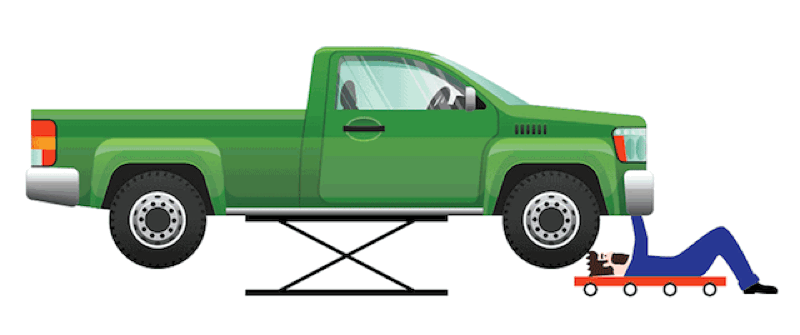
If there’s one thing that entry-level hydraulic lifts have going for them (other than the low price), it’s the ‘gee whiz’ factor of pushing a button and watching your vehicle go up and down. If you’re looking for a lift that will draw ‘oohs’ and ‘ahhs’ from the crowd at your next track outing, this might be the way to go.
3. The Kwik-Lift
The Kwik-Lift is in a class by itself, as it’s one of the only lifts on the market that works great in a low clearance garage without using cheap hydraulics. The Kwik-Lift features:
- Adjustable length and width – it can be used with all sorts of vehicles, from UTVs to a brand new Lamborghini
- Because the Kwik-Lift has no hydraulics, it’s completely bulletproof – no leaks, no motor failures, no “one side of my lift is stuck” problems, etc. Maintenance is just keeping the lift painted and lubricated.
- Because the Kwik-Lift raises a vehicle at the point where it contacts the ground, it offers 24-28″ of lift between the ground and the underbody
- The Kwik-Lift is easy to disassemble and transport, making it truly portable, even if it’s just one person transporting the lift
- Because the Kwik-Lift is a ramp, it works great with most low ground clearance vehicles
With a 5,000 lbs weight limit, the Kwik-Lift is capable of lifting all but the largest trucks and SUVs. Again, we’re biased, but we don’t think anyone offers a better low clearance lift.
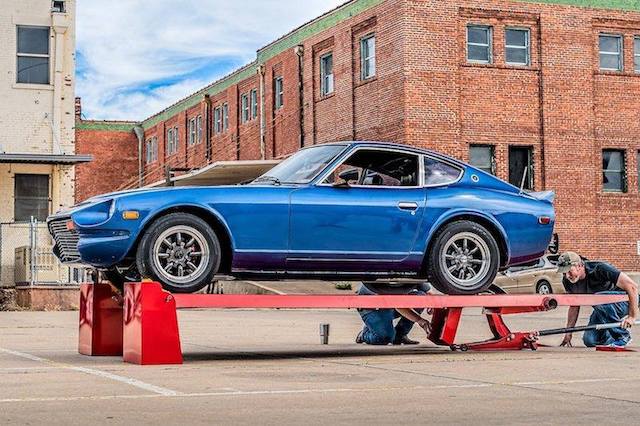
What To Look For In A Low Clearance Vehicle Lift
If you’re shopping for a low clearance vehicle lift for your home garage, there are a few things to keep in mind.
- What happens if the hydraulics need replaced? A lot of the companies selling entry-level hydraulic lifts today do NOT offer replacement hydraulic motors.
- How much clearance does the lift really create? If you’ve got a low ground clearance vehicle, this is especially important to you. The reason is that scissor style lifts work against the frame, rather than the tires. If you have a scissor style lift that can raise a car 18″ (for example), that’s only 18″ of space between the ground and the underside of the car. What’s more, if the lift gets ‘wobbly’ at full extension, you may not feel comfortable using the full height available.
- What’s the minimum ground clearance? Most scissor style lifts require 4″ of ground clearance. If you’ve got a Corvette (for example), you might have trouble using a scissor style hydraulic lift. Even if the lift will slide under your vehicle, it might not be able to pick up your car without a little bit of “run up” (most of these lifts can’t operate from a fully flat position).
- How easy is it to resell the lift? This question is important if you plan to have a bigger garage with space for a real 2 post or 4 post lift someday. If/when you upgrade your garage, it’s a simple matter to resell your Kwik-Lift online. There are no moving parts, so you can get a good price as long as the lift has been well cared for. Used hydraulics, on the other hand, are very difficult to sell, as most buyers assume they will fail and require an expensive repair. After all, how much would you pay a total stranger for a used entry-level hydraulic lift?
- Is the lift portable? A lot of portable lifts weigh a couple of hundred pounds, and unlike the Kwik-Lift, they can’t be broken down into components to make them easy for one person to move. If your “portable” lift requires two people to load and unload every track day, it’s not very portable.
- Is the lift stable? It’s a cliche, but you shouldn’t buy a lift you don’t trust. A lot of people have stories about entry-level hydraulic lifts that get ‘wobbly’ at full extension, about vehicles tipping forward or backward while work is being done, and/or about lifts raising and lowering unevenly. If a vehicle falls when it’s up on a lift, it’s always bad. Even if someone isn’t hurt, there’s vehicle damage. There’s no point in taking a risk if you don’t have to.
Summing Up
Low clearance or low rise car lifts are a great investment for serious automotive DIYers with low ceiling garages. They can save money and time, and they can also make working on a vehicle more enjoyable (fewer aches and pains).
If there’s a problem with low-rise car lifts, it’s that a lot of the companies selling them prioritize the ‘gee whiz’ aspects of hydraulics over the tried and true benefits of a simple solid steel lift mechanism. At Kwik-Lift, we’ve put a lot of effort into creating a low clearance vehicle lift that works well for all cars, that’s simple and reliable, and completely safe.
If you’re in the market for a low rise car lift, be sure to check out a Kwik-Lift.
2 Comments
What if I need to pull the wheels?
Rob, we apologize. Your comment got lost somehow and we are just now seeing it. You can check out this link to see how to remove wheels while your vehicle is on the Kwik-Lift. Please let us know if you have any other questions.
https://www.kwik-lift.com/faqs/#is-there-a-way-to-remove-my-wheels-and-tires-after-the-car-is-on-the-lift–

